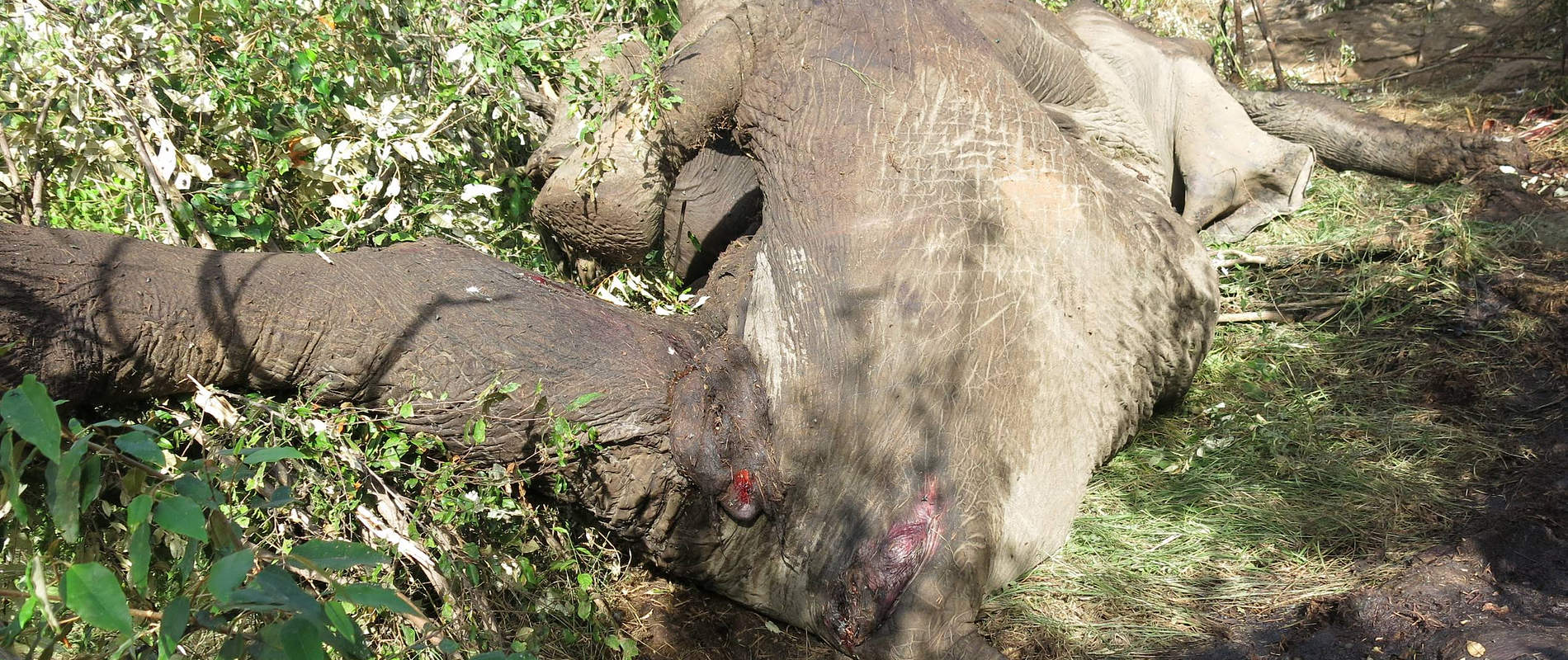FIELD VETERINARY REPORT FOR MASAI MARA FOR THE MONTH OF JUNE 2016 By Dr
FIELD VETERINARY REPORT FOR MASAI MARA FOR THE MONTH OF JUNE 2016
By Dr. Campaign Limo
Introduction
The month was characterized by drop in precipitation and more sunny days. There is still plenty of food and water for the wildlife to utilise. However, there were unfortunate incidences recorded that involved Human Wildlife Conflict with two elephants treated for injuries sustained after raiding community farms. One of the elephants treated was later fatally speared after going back to the crop farms. One male black rhino was also treated for injuries within the reserve and his condition is being monitored closely. One female leopard had to be trapped and relocated to the Masai Mara National Reserve after causing havoc in community areas killing several dogs, sheep and goats. Inquiry and a check-up on most animals treated the previous month indicate they are doing well.
The following were cases handled during the month:
CASE#1 Treatment and Re-collaring of an Elephant Bull
Date: 8th June 2016
Species: African elephant
Sex: Male
Age: Adult
Location: Olchoro-Oiroua conservancy
History
This massive bull collared three years ago was seen with an injury on his left rump. He is known to invade crop farms and was reported to have visited farms in the recent past. Mara Elephant Project team called the veterinary unit for help in treating this elephant christened Bobo, and at the same time replace its failing collar.
General observation
Bobo was alone at the foot of a hill at Olchoro Oiroua conservancy in a thicket. Examination from the air showed he had an injury that required treatment on his left rump. Though calm, he was hesitant to come out of the thicket. His body condition overall was good.
Immobilization examination and treatment
Restraint was achieved by use of 16mgs etorphine hydrochloride delivered in a 3ml Dan inject dart. Darting was carried out from a helicopter. It took nine minutes for the drugs to take full effect with the elephant assuming sternal recumbence. He was immediately flipped over to lie on his left side in order to avoid compromising respiration.
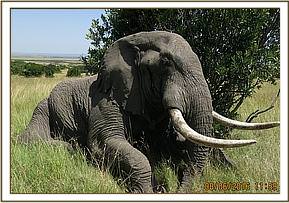
Examination of the wound revealed it could have caused by an arrow shot a week prior to intervention with the wound becoming septic. Further probing did not reveal any foreign object and the arrow head was thought to have fallen out. The wound was debrided with hydrogen peroxide, wiped with gauze and tincture of iodine wasapplied. Green clay was then packed to absorb toxins and hasten healing. Replacement of the collar was going on simultaneously with a GSM/Satellite collar being deployed. This elephant received 30000mgs amoxicillin antibiotic and 4000mgs flunixin meglumine anti-inflammatory all intramuscularly. Soundness of the collar was confirmed while the elephant was still under anaesthesia and this will help in monitoring him as he is a habitual crop raider.
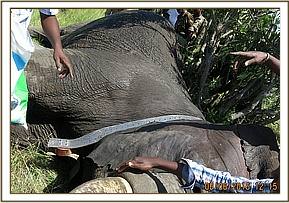

Reversal
Achieved by administration of 48mgs diprenorphine hydrochloride through the ear vein. He woke up in four minutes and climbed up the hill.
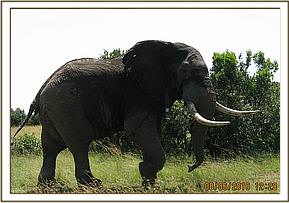
Prognosis
Sadly Bobo was fatally speared two weeks after treatment following another raid on crop farms. He was speared between 20th and 21st June and his fresh carcass found on the morning of 22nd June 2016 with visible spear wound on his left flank. Ingesta was seeping through the opening. Subsequent post mortem revealed a penetrating wound caused by a spear that tore his large intestines with severe contamination of the peritoneal cavity. He died of acute peritonitis as a result of this. Stomach contents showed he had recently fed on cereals mainly maize grains and sorghum suggesting that he had visited crop farms, a scenario confirmed by tracks of his collar.
Case#2 Capture and Translocation of a Problem Leopard
Date: 9th June 2016
Species: Panthera pardus
Age: Young adult
Sex: Female
Location: Released at Masai Mara National Reserve. Captured near Ewaso Ngiro
This leopard was blamed for several livestock and pet loses within community areas and was successfully captured in a trap after several complaints from households affected. It was decided that the ideal release site was the Mara Reserve, several kilometres away from where she was captured. After thorough examination, she appeared to be in good health and was released deep in the reserve in the hope that she would settle down.
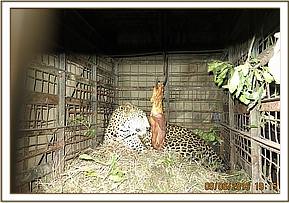

Case#3 Injured Young Elephant Bull
Date: 10th June 2016
Species: African elephant
Sex: Male
Age: Young adult
Location: Aitong area
History
This elephant was seen by the Mara Elephant Project team together with KWS rangers with a fresh injury on one of his front limbs. He was among a group of elephants who for the past two days prior to intervention had raided crop farms in Munyas area near Aitong. Some of the elephants were said to have been shot with arrows by the community members. A scan of several herds within the area could not reveal any elephant with arrows protruding. The arrows could have fallen out since fallen.
General observation
This young bull was alone a few meters away from the rest of the herd limping while walking. He could not completely come out of the thicket. Helicopter darting was preferred as this would aid in driving him closer to the edge of the bush.
Immobilization, examination and treatment
Immobilization was achieved by use of15mgs etorphine hydrochloride delivered in a 1.5ml Dan inject dart. Darting was done from the air after driving this elephant close to the edge of the forest. It took seven minutes for the drugs to take full effect with the elephant going down on his right lateral side.
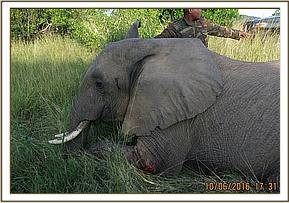
Examination revealed a fresh wound on his front left limb about eight inches deep and seven inches wide which was bleeding and most likely caused by a spear.
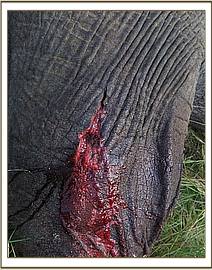
The wound was wiped clean with sterile gauze swabs. Tincture of iodine was applied and cloxacillin ointment infused. The wound was then packed with green clay. Additional treatments included intramuscular administration of 15000mgs amoxicillin antibiotic and 2500mgs flunixin meglumine anti-inflammatory.
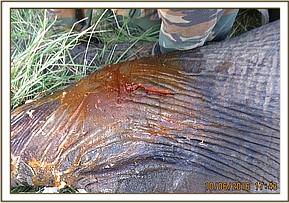

Given that this elephant is in a herd prone to conflict with the communities in the area, it was decided that a GSM collar be deployed on him briefly for monitoring and be removed as soon as the situation calms down.

Reversal
Achieved by administration of 42mgs diprenorphine hydrochloride through a prominent ear vein. He woke up and dashed into the bush three minutes later.
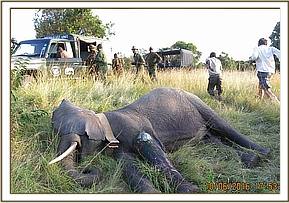
Prognosis
Good.
Case #4 Post-mortem of an Elephant Bull
Date: 13th June 2016
Species: African elephant
Sex: Male
Age: Adult
Location: Naboisho Conservancy
History
This elephant carcass was seen by Naboisho patrol rangers together with the KWS Rangers on their joint patrol. They informed the Vet unit to come for assessment and try to establish the cause of his death.
General examination
This carcass though relatively fresh, had been extensively devoured by hyenas some of whom were found in the vicinity. Vultures were also scavenging on the carcass with the internal organs already consumed.
The carcass was estimated to be 3 to 4 days old with the external surface showing bite marks by scavengers as they tried to rip it open. The tusks were intact and were collected by the KWS security team for accounting and custody. The carcass was a shell as all the internal organs had been eaten by hyenas.
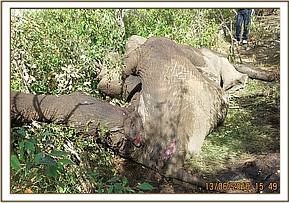
Owing to the state of this carcass the cause of death could not grossly be determined and no viable samples could be collected.
Case #5 Injured male black rhino at Masai Mara National Reserve
Date: 17th June 2016
Species: Black rhino
Sex: Male
Age: Adult
Location: Masai Mara National Reserve (Makalia area)
History
This rhino was seen by the Masai Mara Rhino monitoring team the morning on the same date, severely limping with fresh blood coming from his left hind leg. He took refuge in a big bush within the Reserve out of sight from everyone. They requested our services to help immobilize and treat him.
General observation
Given that this rhino was out of sight from everyone, it was only feasible that helicopter services be sought for search and darting. This was readily availed and a search ensued. He was finally located not far from the edge of the bush, limping severely from his left hind limb.
Immobilization, examination and treatment
Immobilization was achieved by use of a combination of 4.5mgs etorphine and 80mgs azaperone in a 1.5ml Dan inject dart. Darting was carried out from the air. It took ten minutes for the drugs to take full effect with this rhino assuming sternal recumbence.5mgs butorphanol tartarate was administered intravenously through ear vein to stabilize him before examination and treatment.
Examination revealed a deep bleeding wound on the inner side of his left hind leg about half inch in diameter medio-dorsally directed. There was a crack on the tibio-fibular bone that was evident on palpation via the wound opening. Luckily there was no complete fracture. Probing could not reveal any foreign object but the wound appeared very deep. This was considered to have been caused by a high velocity projectile, possibly a gun shot.
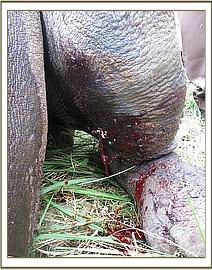
There was also a superficial abrasion wound on his left flank which did not appear serious, possibly caused by rubbing on sharp rocks or tree stumps while fleeing.
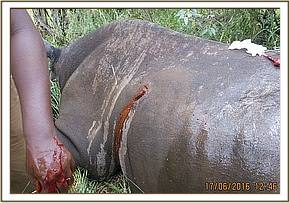

Treatment involved stopping the bleeding by arresting bleeders, cleaning the wound with clean water and disinfecting it with tincture of iodine. Cloxacillin ointment was infused and the wound was packed with green clay.
As for the abrasion wound, it was rinsed with clean water, wiped dry with gauze swab and tincture of iodine was sprayed on top. Oxytetracycline topical wound spray was then applied.
Additional treatments involved intramuscular administration of 9000mgs amoxicillin antibiotic and 2000mgs flunixin meglumine anti-inflammatory.
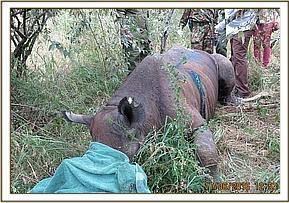
Reversal
Achieved by intravenous administration of 12mgs diprenorphine hydrochloride through an ear vein and 50mgs naltrexone intramuscularly. He woke up after four minutes and stood briefly before moving away.
Prognosis
Fair.
A follow-up not long later showed he had improved greatly and managed to move more than two kilometres from where he received treatment. Close monitoring by the rhino team continues with regular updates on his progress.
Case #6 Giraffe at Kawaii
Date: 17th June 2016
Species: Masai Giraffe
Sex: Female
Age: Young adult
Location: Kawaii (Trans-Mara)
History
This giraffe was seen by the Ann K Taylor Anti-snaring team together with the Mara Triangle patrol rangers in a group of four others, limping while she walked along. They thought she had a snare and called us for help.
General observation
She was seen with the rest of the giraffes browsing with an obviously swollen right hind limb. The swelling was on the metatarso-phalyngeal joint. This caused her limping gait.
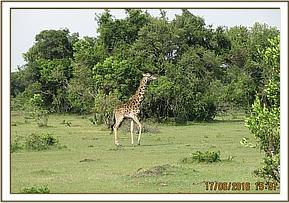
Immobilization, examination and treatment
Immobilization was achieved by use of a combination of 8mgs etorphine hydrochloride and 50mgs azaperone in a 1.5ml Dan inject dart. Darting was done from a vehicle. This giraffe was fully narcotized after eight minutes whereupon she was roped down.
Examination revealed an old and healed snare wound with resultant swelling and deformity of the joint. This is a giraffe we removed a snare from more than two years ago. At the time, she had complications of septic pedal arthritis which was treated yet she healed with a slight deformity.

She received 1500mgs flunixin meglumine anti-inflammatory and 6000mgs oxytetracycline hydrochloride antibiotic, all intramuscularly.
Reversal
Achieved by administration of 24mgs diprenorphine hydrochloride intravenously through the jugular vein. She woke up within two minutes and joined the rest of the giraffes.
Prognosis
Good. She can live with the deformity.
Case #7 Injured Young Elephant
Date: 20th June 2016
Species: African elephant
Sex: Male
Age: Sub adult
Location: Olarro Conservancy
History
This young bull, in a group of about two hundred elephants, was seen by Olarro conservancy managers with an injury on his spine. They called the unit for help. The group was reported to have recently moved into the conservancy from Olkinyei area. These elephants had gone to a bushy part at the base of a hill within the conservancy and after two hours of searching, this elephant could not be traced. Helicopter services were then requested for search and possible darting. This bore fruits as he was finally located within the rest of the elephants in a thicket at the base of the hill.
General observation
He was seen with a discharging wound about three days old, on top of his spine at the sacral portion.
Immobilization, examination and treatment
Restraint was achieved chemically by use of 10mgs etorphine hydrochloride delivered through a 1.5ml Dan inject dart. Given that this elephant was already agitated, darting was done from a helicopter.
It took twelve minutes for the drugs to take full effect. In the meantime the elephant was being pushed into the open and prevented from returning to the thicket. He assumed right lateral recumbence.
Examination revealed a spear inflicted wound about three days old on his sacral spine. Fortunately it did not damage the spinal column but left a big gaping subcutaneous wound. No foreign object was detected as the spear could have since fallen out.

The wound was lavaged with copious amount of water and debrided with hydrogen peroxide. Tincture of iodine was applied for disinfection before being packed with green clay. Additionally he received 15000mgs amoxicillin antibiotic and 2000mgs flunixin meglumine anti-inflammatory, all intramuscularly.

Reversal
Achieved by administration of 24mgs diprenorphine hydrochloride intravenously through a prominent ear vein.
He woke up within three minutes of reversal to join the rest of the herd.
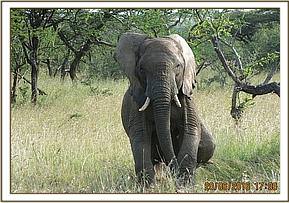

Prognosis
Good.
Case #8 Examination of an Elephant Cow
Date: 22nd June 2016
Species: African elephant
Sex: Female
Age: Adult
Location: Saruniarea (Mara North)
History
After the spearing and subsequent death of Bobo the collared male, there were concerns about the status of the other elephants in the area especially those who could possibly have gone to crop farms with Bobo.
After carrying out post mortem examination of Bobo, an aerial recce was conducted to check on the other elephants. A female elephant with two calves was seen with a collar that was expiring with a wound on her nape. This was Ivy, female elephant collared three years ago.
The unit decided to immobilise her for closer examination.
Immobilization, examination and treatment
15mgs etorphine hydrochloride was prepared to immobilize Ivy. She became adamant to move further into the bush despite spirited efforts to drive her out and the only viable option was to dart her from the air. She finally gave in to anaesthesia after ten minutes near the edge of the forest. The young ones were driven away to give room for their mother to be attended to.
Examination revealed a small wound on her nape which appeared to be caused by abrasion. This was not a serious wound and topical oxytetracycline antibiotic spray was applied with additional 15000mgs amoxicillin antibiotic given intramuscularly.
A decision to replace her collar with the one removed from Bobo was also arrived at and carried out.


Reversal
Achieved by intravenous administration of 42mgs diprenorphine hydrochloride through a prominent ear vein. She woke up to join her calves within four minutes.
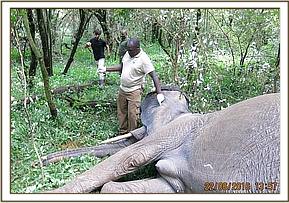
Prognosis
Good.
Case #9 A Fence Wire Entangled around a Giraffe
Date: 27th June 2016
Species: Masai giraffe
Sex: Female
Age: Sub adult
Location: Mara Simba
History
This giraffe was seen early in the morning of this date by Mara Simba staff, recumbent and entangled in a fence wire. They called the veterinary unit for help.
General observation
We found this giraffe motionless with both hind limbs trapped by plain wire strands of a fence. Blood was oozing from her nostrils and her perineal area had been scavenged by hyenas. Both eyes had been gauged out by vultures. Closer examination revealed she might have died less than six hours before our arrival. There was evidence of a struggle before death with indications of self-inflicted trauma to the head as she struggled to free herself.
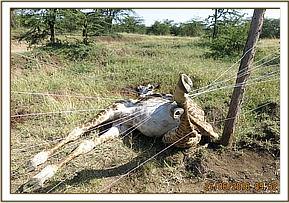
It was concluded she died of fatigue and head injury as she struggled to disengage herself, hitting solid ground with her head.
The carcass was removed and disposed of in a small thicket away from public view.
Conclusion
The Mara Mobile Veterinary Unit is grateful to all stakeholders who participated in reporting, treatment and monitoring of the wild animals handled during the month. Thanks to Minara Foundation through The DSWT for their continued facilitation to the unit. Thanks too to KWS management for their guidance and advice to the unit. All your support is highly appreciated by the unit.
